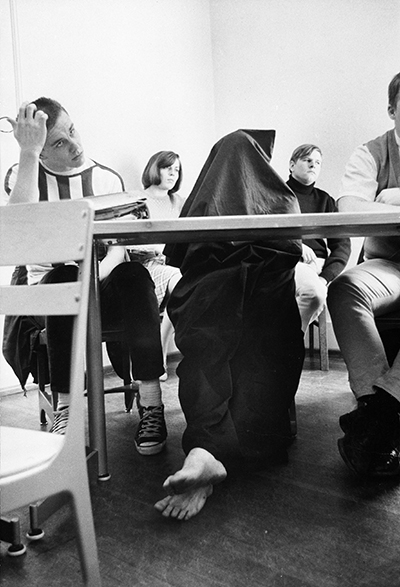From the Winter 2023 issue of the Oregon Stater magazine
As they returned to sleepy Corvallis after winter break of 1967, the roughly 20 Oregon State students in instructor Charles Goetzinger’s basic speech persuasion class had no idea that what was about to happen in their class would draw international attention and become one of the oddest stories in university history.
There, at the back of the classroom, sat a person wearing a black fabric bag from the top of his head down to his bare ankles and feet. Goetzinger assured the class that “The Bag” was indeed an ordinary student who had asked to remain anonymous, but what happened over the next few months was far from ordinary. As word spread of The Bag, network television crews and other national media — including the Associated Press, United Press International, Life magazine and even Walter Cronkite’s “CBS Evening News” — descended on Corvallis in droves.
At first the attraction seemed to be the old “those wacky college kids and their harmless pranks” angle — quaintly reassuring, considering that this was the tumultuous ’60s and tensions were growing around the Vietnam War, the Civil Rights movement and what many Americans saw as an erosion of key values, especially on college campuses.

But maybe it wasn’t just a prank. When the Oregon State Daily Barometer broke the story on Feb. 3, writer Jody Jaross noted the timing of The Bag’s classroom debut. It came the day after the Baro published a syndicated column by renowned San Francisco satirist Art Hoppe. It described a lone man wearing only a black fabric bag in London’s Trafalgar Square who maintained that the world’s problems might be solved if humans all looked alike. “So, the Black Bag Movement, once the ice is broken, is bound to sweep the world,” Hoppe wrote, tongue firmly in cheek. “And we can all look forward to a warm, secure, contemplative future without racial conflict, a war in Vietnam, a population explosion or topless dancers.”
The next day, OSU’s Bag Man appeared, and by late February, a UPI story published around the world reported that The Bag believed people tend to judge others by their clothes, skin color, features and expressions, and he wondered what their judgments would be when these factors were gone.
At first, many of his classmates resented The Bag as a distraction. “One freshman followed The Bag as he walked from the classroom and tried to paste a ‘Kick Me’ label on him,” reported Life magazine. “In a later session, The Bag sat opposite the offending freshman and stared at him intently through the black cloth. In horror, the freshman screamed: ‘Get away from me!’ — and probed at The Bag with an umbrella.”
However, as the weeks passed, most of his classmates simply accepted The Bag and many became protective of him, shielding him from prying journalists. Parents and alumni wrote letters expressing emotions ranging from outrage at The Bag’s presence to pride at seeing OSU get attention for something other than athletics.
Today, this Oregon State story lives on in psychology and marketing lore as an example of the “mere exposure effect,” popularized in 1968 by University of Michigan scholar Robert Zajonc. He cited OSU’s Bag Man as a primary example of the idea that people will grow to like a thing they initially detest — even with no new information — if they are repeatedly exposed to it.
Jason Stornelli, an associate professor of marketing in OSU’s College of Business, studies how people make judgments and decisions. “We don’t necessarily have to commit to dress head-to-toe in unusual clothes for a term to see the influence of the mere exposure effect for ourselves,” Stornelli said. “We can probably all think about a song, a flavor of food or drink, innovative architecture or a design for a new model of car that was at first unusual and that we didn’t like much, but as it became more familiar, our liking for that thing grew.”
As for the fate of OSU’s Bag Man? Many on campus thought he would reveal his identity at term’s end, but when the day came, he quietly left class and was picked up by a waiting car. He was driven to a nearby building, entered it wearing the bag and was never seen again.


